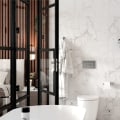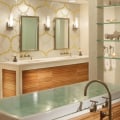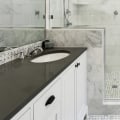The kitchen may be the exception, but, even here, there is invariably the reassuring presence of a kitchen designer to smooth out the process. With the bathroom, you will often find yourself managing only the plasterer, plumber, and floor installer, so it can be a little overwhelming. The typical bathroom is small, requires clever use of space to fit all the desired features and make it attractive and comfortable at the same time. And the installation can be deceptively complicated, as it involves plumbing, intricate spatial design and technical skills.
Just like planning a kitchen, when you get closer to how to design a bathroom you can start shooting by analyzing how you use your current room, looking at what works and what doesn't. Then look at the bathroom pictures for inspiration and draw up a wish list that takes into account all potential users, their individual needs, and imagine how they might change in the future. For example, a family bathroom will generally require a bathroom, sturdy and splash-proof surfaces, while a master bathroom or suite can afford to be a little more luxurious. Since there are so many bathroom design ideas to choose from, how you plan your new bathroom layout will depend on many factors.
This includes the function of the bathroom, the size, who will use the bathroom and how often. Ideally, work with minimal bends in the toilet pipes to avoid clogging, so relocation may require significant effort, but it is not impossible. Work is easier if the new location follows the direction of the floor joists. It is also possible to move one more toilet along the external wall housing the earth pile, by drilling a new hole through the wall and connecting it to the ground pile externally.
Another option is to install a new raised floor, with sufficient depth for the pipes below, but this will result in a step in the room. Duplicate bathroom vanity ideas, sinks and mirrors where space permits and don't be tempted to vacate the bathroom if it's the only one in the house. In an en-suite master bathroom, only used by responsible adults, you can afford to throw caution to the wind and splash luxurious materials and a more complex lighting scheme to create a relaxing atmosphere. If there is space, opt for his and hers vanity areas with attached walk-in closets if you're very lucky.
This is the place to spend on expensive and modern bathroom ideas, such as a steam shower or an elaborate sound system, which could be damaged by handling small children or clueless guests, and to enjoy luxurious surfaces in their individual style. If space is complicated, get creative with your small bathroom ideas and consider a bathtub in the bedroom with only a small sectioned area for the toilet and sink. Bathrooms and guest suites can often be compressed into a surprisingly small space with space-saving fixtures and a cloakroom sink. Keep it simple, safe with showers with thermostatic valve and easy to clean.
Various ideas and designs for wet rooms are available, from ultra-minimal frameless options to bold bold black Crittall styles. Smart bathroom lighting ideas can have a massive impact on the bottom line and should be planned at an early stage to ensure that all key fixtures are lit correctly. Aim for sufficient working lighting in shower and vanity areas, as well as ambient lighting around the bathtub and in niches and niches. Latest intelligent lighting controls allow for pre-programmed adjustments.
Bathroom tile ideas made of porcelain, natural stone, terracotta and encaustic are beautiful if you are looking for bathroom flooring ideas. So you have your plans in order, but what else should you keep in mind when planning a bathroom? New glossy accessories can highlight imperfections in the original space, so it's worth updating architectural elements such as doors, baseboards and cornices. A simple layer of plaster can fix a scruffy ceiling. Well-dressed windows will also help to create a truly stylish finish.
Plantation blinds designed for use in the bathroom will provide privacy and are easy to clean. Don't forget to save some budget for beautiful accessories that will unite the whole look. If you're wondering if adding an extra bathroom will add value to your home, the move is likely to pay off. Adding extra bathrooms is a recognized way to increase the value of your property and can work wonders in the morning rush hour.
Options include converting an adjacent box room into a private bathroom, stealing an unused area from an overhead landing, or using stud walls to section out a large room. Clever utility or cloakroom ideas downstairs can incorporate a bathroom with shower if there are no upstairs options. The advent of electric showers and pumped drainage systems, such as macerators, means that there are few spaces that cannot accommodate bathroom fixtures. Macerators are noisier than gravity drainage, but many people can accept the compromise, especially if the additional bathroom is only designed for occasional use by guests.
Plumbing a new room is easier and cheaper if it is located next to an existing bathroom or above the kitchen, and not too far from the external ground pile, so that the pipes do not have to travel far. If you want to know what makes a bathroom good, the secret is that it depends entirely on individual needs. Each person will have different priorities, so they should be taken into account. For example, a family bathroom may need a bathtub and shower, plus plenty of storage space, while a private bathroom may need a small shower and toilet.
Design is also key and how it works in the space you have. It's also a good idea to think about both lighting and storage and how best to achieve this. Jennifer is the digital editor of Homes& Gardens. Having worked in the interior industry for several years, covering many publications, he is now honing his digital prowess on the 'best interior website' in the world.
With multiple skills, Jennifer has worked in public relations and marketing, and occasionally forays into the social media, commerce and e-commerce space. Use these great patio ideas to help you design the garden of your dreams, from a sociable dining room to a backyard designed for relaxation. These desk organizers are vital to give your desk style and streamline your work process. RoomSketcher provides an easy-to-use bathroom planner that you can use to create a bathroom design online.
Visualize your bathroom design ideas and turn them into reality. In no time, you can create 2D & 3D floor plans and images of your new bathroom design in 3D to show to your contractor, interior designer or bathroom accessory salesman. Start by thinking about what you want, rather than what you need, and get the family involved too. You may be craving a deep, freestanding bathtub, but your partner may want a smart, walk-in shower.
Once you have a list of your wants and needs, think about your budget. While decorative items such as paint and wallpaper can be kept quite cheap, sanitary ware and any kind of smart technology can quickly push the budget off course. Get the right design of your bathroom the first time. All the knowledge and inspiration you need are in our expert guide.
Perrin says powerful ventilation is needed to get moisture out of the bathroom of the house. Specifically, the Institute for Domestic Ventilation (HVI) recommends that bathrooms smaller than 100 square feet have an exhaust fan that provides 1 CFM (cubic feet per minute) per square foot (approximately eight air changes per hour). Toilets, showers and bathtubs need 50 CFM each, according to the HVI. A hot tub needs 100 CFM.
An average American uses 70 gallons of water indoors every day per person, and 25 percent of that water goes down the drain when we flush the toilet chain, says Diana Schrage, senior interior designer at Kohler. They are still outdated and inefficient models, he says. A high-efficiency toilet can save up to 16,000 gallons of water per year for an average family of four and is not compromising flush power when choosing a high-efficiency toilet. Look for a high-efficiency toilet that uses less than 2 gallons per flush.
The average is 5 gallons per flush. By selecting an efficient faucet, you can save 45 percent more water compared to older standard fittings, which equates to approximately 14,000 gallons of water per year for an average family of four, Schrage says. This 18th-century inspired bathroom design idea comes from designer John Cottrell and architect Gil Schafer. The centerpiece of the master bathroom in a home in Aspen, Colorado, by designer Shawn Henderson and architect Scott Lindenau is a custom-made Japanese bathtub with Dornbracht accessories.
The design team created a sun-drenched room with soft green painted walls and mirrored surfaces that reflect both light and views. Think about the reasons for your remodel, assess your bathroom needs and design a space that meets your goals. Another of our favorite bathroom design ideas, this outdoor bathroom boasts a breathtaking view of the mountains in Aspen, Colorado. A current trend is graphic ceramics, for example, a mosaic of decorative geometric elements or a striking hexagonal design.
The master bathroom of a Hamptons house designed by Steven Gambrel features pendant lights by Rejuvenation, a Ralph Lauren Home wall light and a pair of vintage French chairs by Aero; sink fixtures are from Waterworks. Designed for outdoor use, they are moisture and mildew resistant and come in an expanding range of indoor-quality patterns and colors. A bathroom design that offers style and practicality can be yours, and you're in the right place to find out how. In reality, these room sets have been designed around the suite with perfect proportions, so you'll never feel overwhelmed or “too much”.
Tiles designed for floors are extremely durable; they resist water, stains and wear, and are easy to care for. Imagining a house where “every window was an image,” Robert and Alexandra Norse commissioned architect Jack Lionel Warner and designer Barbara Barry to build their home in Montecito, California. Wall tiles are a must-have design for the bathroom to protect them from water, whether in the shower area, next to the bathtub or behind the sink. It is the most widely used feature in your bathroom and the only accessory you don't want to place as a design focal point.
Good bathroom storage is essential in the bathroom design process to avoid cluttering bathroom surfaces with toiletries, spare toilet roll and clean towels. . .



Leave Message